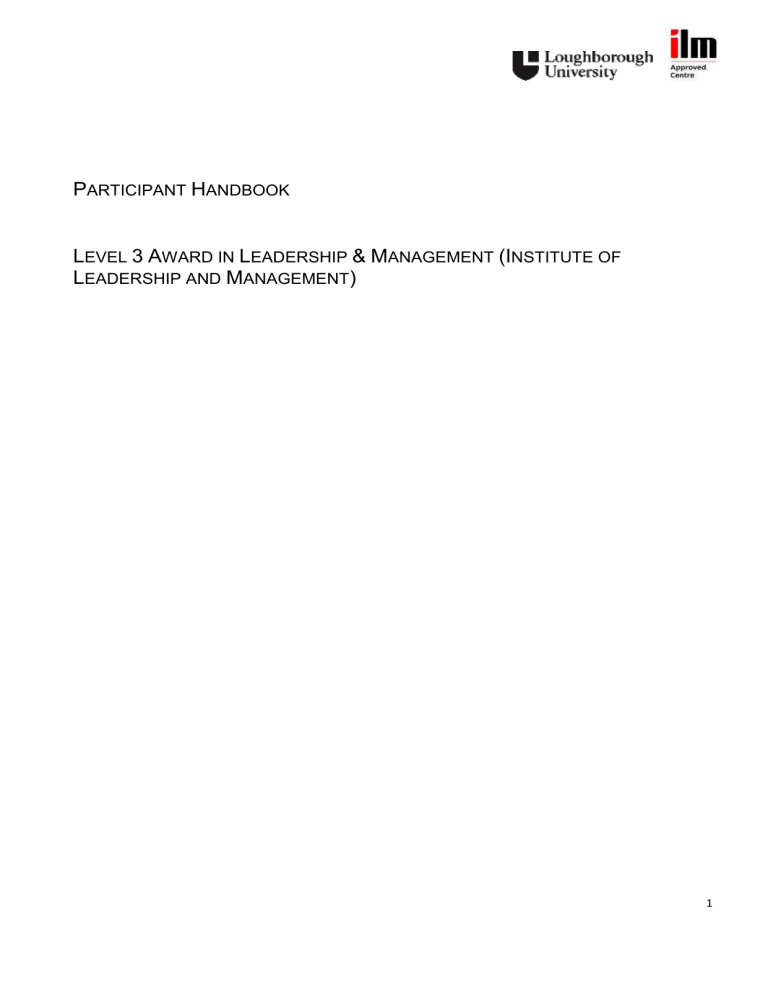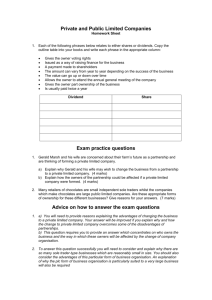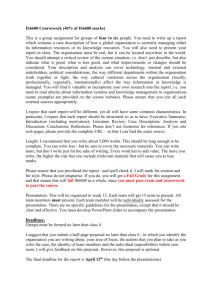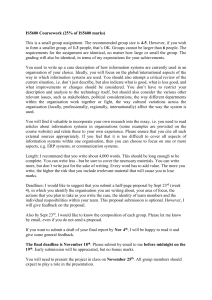ILM 3 handbook updat.. - Loughborough University

P
ARTICIPANT
H
ANDBOOK
L
EVEL
3 A
WARD IN
L
EADERSHIP
& M
ANAGEMENT
(I
NSTITUTE OF
L
EADERSHIP AND
M
ANAGEMENT
)
1
I
NTRODUCTION
Welcome to your Award in Leadership programme, specifically designed for and by Loughborough University.
Aim of the programme
The aim of the programme is to provide you with an understanding of leadership at Loughborough, to help in your role & in improving the performance of the staff and the teams you lead, or aspire to lead in the future. If you are already leading a team then you will be required to reflect on your new knowledge and skills and put them into action to improve the effectiveness of the team. If you are an aspiring team leader then you will be required to reflect on a team you work with closely and ideally have the opportunity to get involved with implementing the things discussed on the programme.
Entry requirements
There are no formal entry requirements for this programme. However, to benefit from this course it would be advantageous to have an opportunity to put the new learning into practice, and therefore you will need to be in a team leading or management role. No prior management qualifications are necessary, or prior educational qualifications. However you will need to submit some written reports, so an ability to read and write English would be advantageous.
Student support
Loughborough University is an accredited centre for ILM and is committed to inclusion and we can provide a range of support for learners with disabilities and/or learning difficulties. If you feel you may require support on your programme then please contact our advisers team directly (please see candidate handbook for further details).
Attendance
The achievement of the Award is dependent upon attendance at ALL of the units/workshops. These learning hours are a specific requirement of the ILM process. A key aspect of any team leader or manager is their management of themselves, their workload and their time. The achievement of this Award should reflect their ability to attend all of the units they have committed to as well as completion of the assessment in the required timescale.
2
P
ROGRAMME OVERVIEW
Units Content
Understanding
Leadership
Leading and motivating a team effectively
This unit looks at you as a team leader and focuses on your responsibilities and levels of authority. We also consider ways to develop yourself as a leader, looking at areas such as receiving feedback and setting your own personal improvement plan.
By the end of this unit you will be able to:
Understand the roles, functions and responsibilities of the team leader, and the limits if your authority and accountability
Know how to seek, accept and respond positively to feedback on personal performance to improve workplace performance
This unit focuses on helping you to understand more about how your team functions. Looking at ways to improve team performance and also how to assess the training needs of the team and address these needs.
By the end of this unit you will be able to:
Understand the nature of teams and the features of team roles and responsibilities including the advantages and disadvantages
Know how to identify training needs of a group or team and how those needs may be met
Additional notes
Understanding
Performance
Management
Managing Resources to ensure Value for
Money
This unit looks more closely at the performance of the team.
Considering the levels of performance expected and how these are determined, addressing underperformance and understanding what motivates people.
By the end of this unit you will be able to:
Understand the organisation’s requirements in relation to individual performance
Understand how to address underperformance
Understand what motivates people
This unit aims to develop knowledge and understanding of managing costs, as required by a first line manager.
By the end of this unit you will be able to:
Know how to get value for money, with the resources you have
Understand how to manage costs
3
A
SSIGNMENT INFORMATION
All submitted assignments must be emailed to ilm@lboro.ac.uk
by the dates given.
You must include your name, course and assignment title in the file name. Please also ensure your work is submitted as one document
and it must have a submission sheet as the front cover. We are unable to accept assignments without this front cover and we will ask you to resubmit if it is not included.
Please note you do not need to include your learner registration number on this sheet. If you require confirmation of receipt of your emailed submission then please request this from the “Options” tab in
Outlook.
Guidelines on submitting as one complete PDF document:
1. When saving your word document, save it as a PDF file
2. Open adobe
3. In left hand corner – select the ‘create PDF’ button
4. From drop down menu – choose “combine files into a single PDF”
5. A new window will open (let’s call this X) – in the top left hand corner is an ‘add files’ button. Click and choose how you want to find your files (e.g. ‘add files’ will open windows explorer, ‘open files’ just looks at ones you have open)
6. Once all your files are listed in screen X – click combine. It will open a new PDF which you can then save as the appropriate file name.
If you are unable to send your assignments through by email then you can submit a hard copy (but we must also have a copy on CD or memory stick) by visiting the Staff Development department in
Rutland Building.
Assessment – Reflective Review
Remember that these notes are for guidance only
The assignment includes the Assessment Criteria , showing you exactly how you will be assessed, and a
Mark Sheet to show how the marks are allocated. Read the assignment carefully and study the Assessment
Criteria with even more care. It is a good idea to go through the assignments after you have completed them and mark them yourself, using those same criteria. Ask yourself “Have I done what it asks me to do?” “What mark would I give it?”
Assessment activities are divided into parts . You must use the headings (in bold) of each part to structure your assignment, because marks are allocated according to how well you deal with each of them – if the assessor doesn’t know which part you are answering, you won’t get the marks. Remember, the assessor is not trying to trick you – what it asks for is what it expects. If you have a problem, ask your tutor for help.
You should present your work as simply and clearly as possible . Whilst word-processed assessments are preferred, you will not lose marks for presenting a hand-written assessment so long as it is neat and legible.
Please do not present your work in elaborate folders – simple stapled pages are all that is required.
As a Team Leader, communication skills are very important . So, too, it is important that you write clearly when your present your work for assessment. You may not lose marks for poor grammar and spelling, but it will give a poor impression of your standard of work.
ILM is keen to ensure fair and equal assessment for all candidates: so if you have any special difficulties which you think might put you at a disadvantage do not hesitate to let your tutor know.
What constitutes plagiarism?
If you submit an assignment that contains work that is not your own, without indicating this to the marker
(acknowledging your sources), you are committing ‘plagiarism’ and this is an offence. This might occur in an assignment when:
Using a choice phrase or sentence that you have come across and copying it word-for-word directly from a text.
Paraphrasing the words from a text very closely.
Using text downloaded from the internet, or copied directly from a book or other source.
Borrowing statistics or assembled facts from another person or source.
4
Copying or downloading figures, photographs, pictures or diagrams without acknowledging your sources.
Copying from the notes or essays of a fellow student.
Although you are encouraged to show the results of your reading by referring to and quoting from works on your subject, copying from such sources without acknowledgement is deemed to be plagiarism and will not be accepted by Staff Development.
For further information on how to reference your sources of information, please either discuss this with your tutor, or see the University Library’s guidance sheet to referencing: http://www.lboro.ac.uk/services/library/skills/advice/
5
W
ORK BASED ASSIGNMENTS
Assignment Task for Unit: Understanding leadership
Centre Number: Centre Name:
Learner Registration No: Learner Name:
TASK
The purpose of this unit is to develop the knowledge and understanding of different leadership styles or behaviours to be found in the workplace, including an understanding of your own preferred leadership behaviours, and the impact that these different styles are likely to have on behaviour of team members.
The task requires you to demonstrate this understanding in the context of an organisation with which you are familiar. It also requires you to use feedback to assess and reflect on your own preferred leadership style in order to identify how you could modify behaviours or build upon existing strengths to become more effective in a leadership role.
NOTE:
If you are not currently working within an organisation, then you may complete this task in relation to an organisation with which you are familiar. This could include experience working in a voluntary capacity.
You should plan to spend approximately 12 hours researching your workplace context, preparing for and writing or presenting the outcomes of this assignment for assessment. The 'nominal' word count for this
assignment is 1200 words: the suggested range is between 800 and 1500 words.
Check your assignment carefully prior to submission using the assessment criteria.
Please use the sub-headings shown below when structuring your Assignment
Assessment Criteria
Understand leadership styles
Provide responses to cover these assessment criteria.
Understand leadership qualities and review own leadership qualities and potential
For this section you need to gather information about you own leadership style using feedback from others such as line manager, team members. You may also chose to use some leadership styles self - assessment technique.
The information gathered should be used, in conjunction with a recognised leadership model, to assess your preferred patterns of leadership behaviour and how effective these
Describe the factors that will influence the choice of leadership styles or behaviours in workplace situations (24 marks)
Explain why these leadership styles or behaviours are likely to have a positive or negative effect on individual and group behaviour (24 marks)
Assess own leadership behaviours and potential in the context of a particular leadership model and own organisation’s working practices and culture, using feedback from others are within the working practices and culture of the organisation.
Once this has been completed you need to identify any actions you should take in order to enhance your leadership behaviour.
By submitting I confirm that this assignment is my own work
(28 marks)
Describe appropriate actions to enhance own leadership behaviour in the context of the particular leadership model (24 marks)
6
Assignment Task for Unit: Leading and motivating a team effectively
Centre Number: Centre Name:
Learner Registration No: Learner Name:
TASK
The purpose of this unit is to understand the need for teams to have a sense of vision and purpose that reflects the organisation’s, and the role that effective communication, motivation and individual and team development play in enabling this to happen.
In order to demonstrate your knowledge of this you need to respond to all of the questions listed below.
NOTE:
You may want to relate your answers to an organisation that you work in. If you are not currently working within an organisation, then you may complete this task in relation to an organisation with which you are familiar. This could include experience working in a voluntary capacity.
You should plan to spend approximately 9 hours researching your workplace context, preparing for and writing or presenting the outcomes of this assignment for assessment. The 'nominal' word count for this assignment is 1000 words: the suggested range is between 800 and 1500 words.
Check your assignment carefully prior to submission using the assessment criteria.
Please use the sub-headings shown below when structuring your Assignment
Assessment Criteria
Connect the team with vision and strategy
Briefly describe an organisation and the identified team’s role within it, outlining:
its vision and strategy
the importance of having such a vision and strategy
how the vision and strategy has been translated into objectives for the team
Explain the importance of the team having a common sense of purpose that supports the overall vision and strategy of the organisation (16 marks)
Explain the role that communication plays in establishing a common sense of purpose
(16 marks)
Assess the effectiveness of own
Explain how you can communicate to team members the team’s objectives and how these will contribute to fulfilling the goals of the organisation. communication skills on the basis of the above (12 marks)
Assess how effective you were in communicating this common sense of purpose to the team, using feedback from team members and other evidence to help identify your strengths and areas for improvement.
Motivate and develop the team
Describe how you would:
motivate a whole team to achieve agreed goals
(using a specific theory or model of motivation to help
you to explain your actions);
motivate an individual member of a team to achieve agreed goals, (using a specific theory or model of
Describe the main motivational factors in a work context and how these may apply to different situations, teams and individuals
(16 marks)
Explain the importance of a leader being able to motivate teams and individuals and gain their commitment to objectives (20 motivation to help you to explain your actions);
support an individual team member, giving practical examples of why this may be necessary;
develop a whole team, to work effectively together as a team , giving practical examples of why this may be necessary;
develop an individual team member to enable him or her to perform more effectively , giving practical
marks)
Explain the role that the leader plays in supporting and developing the team and its members and give practical examples of when this will be necessary examples of why this may be necessary.
By submitting I confirm that this assignment is my own work
(20 marks)
7
8






